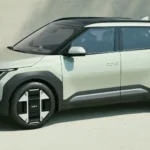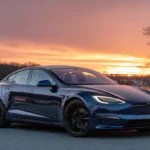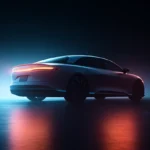Introduction: Why This Claim Matters in 2025
When Tesla CEO Elon Musk proclaimed that his company’s electric-vehicle batteries could “last longer than the car itself,” many skeptics doubted that lithium-ion packs would outlive wheel bearings, upholstery, or even paint. Yet six years later, we have the first cohort of Teslas and other EVs crossing 300,000 miles — and the data are finally robust enough to test the claim. Fleet telematics giants, independent labs, and Tesla’s own Impact Reports reveal a surprisingly consistent story: modern EV batteries degrade far slower than early fears suggested, reshaping depreciation curves and total-cost-of-ownership models.
Elon Musk’s Original Prediction and the Million-Mile Vision
Back in April 2019, Musk tweeted that a Model 3 battery was engineered for 300,000–500,000 miles, while the drive unit and body would target 1 million miles of service life. Around the same time, battery pioneer Jeff Dahn published a landmark paper showing test cells retaining 90 % capacity after 4,000 full-depth cycles — roughly a million road miles — feeding speculation about an imminent “million-mile battery.”
Those projections set a high bar. The question is whether real-world data have caught up.
Methodology: Where the Best Battery-Life Numbers Come From
- Recurrent Auto aggregates continuous state-of-charge telemetry from thousands of U.S. EVs, mapping range against odometer readings.
- Tesla’s 2023 Impact Report summarizes internal warranty and fleet health data.
- Independent analytics from P3 Automotive and Geotab examine 7,000-plus fleet vehicles across brands, according to Wired.
Together, these sources cover diverse chemistries (NCA, NMC, LFP) and climates, giving us high-confidence averages rather than single anecdotes.
The 100K-Mile Mark: Early-Life Capacity Drop
Across Model 3, Model Y, and late-model S/X packs, capacity loss after the first 100,000 miles ranges 8–12 % — basically a fade of 1 % per 10,000 miles once the initial “settling” period is past. Owners often notice the sharpest drop in the first 30K miles as the battery’s buffer calibrates, then a flatter, linear degradation curve.
Chemistry Differences
Nickel-rich NCA/NMC cells (common in Tesla Long-Range trims) show slightly higher early fade but stabilize quickly, while iron-phosphate LFP packs hold steadier from day one yet start with a smaller usable buffer.
The 200K-Mile Test: Do Batteries Still Beat Cars?
Tesla’s Impact Report shows just 12–15 % total loss at 200,000 miles, meaning 85–88 % capacity remains — comfortably above the industry’s 70 % warranty floor. Recurrent’s cross-brand analysis lands in the same ballpark, citing 81–87 % retention for high-mileage Teslas.
Take-away: Even if the rest of the car reaches scrapyard age around 200K miles, the battery itself is still healthy enough for daily commutes or a lucrative second life in stationary storage.
The 300K-Mile Frontier: Anecdotes Becoming Statistics
Reliable 300K-mile datasets are emerging only now, but early signals are striking:
- A 2015 Model S 90D logged 300,000 miles with 88 % of its original range still available.
- P3 Automotive’s fleet study shows 87 % capacity at 300,000 km (≈186K miles); extrapolating its 1.8 % annual fade implies roughly 80 % capacity around 300K miles for typical usage.
While sample sizes remain small, nothing yet contradicts Musk’s mid-life target of 300–500K miles for current chemistries.
Key Drivers of Degradation
| Factor | Impact | Mitigation |
|---|---|---|
| DC Fast-Charging | Frequent 250 kW sessions can raise fade rate by up to 3× in hot climates. | Favor Level-2 home charging for daily use. |
| Extreme Heat | High pack temps accelerate electrolyte breakdown. | Pre-condition before charging; shade parking. |
| Deep Cycling | Regular 0 %–100 % swings add stress. | Keep daily window ~20 %–80 %. |
| High-Speed Driving | Sustained high C-rates generate heat. | Use chill modes when possible. |
Cost Implications: Replacement vs Residual Value
Even today, a full 100 kWh replacement can run $12,000–$15,000 out of warranty. But because capacity retention is far better than expected, very few owners face that bill. Instead, high-mileage EVs with ~80 % capacity are holding residual values comparable to or better than ICE cars of the same age.
Maintenance & Longevity Tips for Owners
- Aim for 70–80 % daily charge; reserve 100 % for road trips.
- Warm or cool the pack before fast-charging in extreme weather.
- Use scheduled charging to finish right before departure, minimizing time at high state of charge.
- Update firmware promptly; OEM BMS tweaks often improve cell balancing and usable buffer.
Following these habits can shave an additional 0.3–0.5 % off annual degradation, extending usable life well past 20 years.
Future Outlook: Solid-State & 4680-Cell Promises
If today’s cylindrical cells can already flirt with half-million-mile lifespans, upcoming solid-state chemistries — targeting twice the cycle life and improved thermal robustness — could make million-mile packs routine, even outside Tesla’s labs. Combined with vehicle-to-grid revenue streams, batteries may end up out-earning the cars they sit in.
Frequently Asked Questions
1. Does fast charging ruin my battery?
Not if used sparingly. Data show only modest extra fade when DC charging accounts for <20 % of total energy.
2. Will I ever need a full battery replacement?
Statistically unlikely before 300K miles; module swaps are cheaper and ever rarer.
3. How does degradation compare to smartphone batteries?
EV packs use active thermal management and larger buffers, resulting in 5–10× longer useful life.
4. What happens after the car is scrapped?
Batteries retaining >70 % capacity are repurposed for stationary storage or recycled for valuable metals.
5. Are warranties keeping pace with real-world performance?
Yes. Some OEMs now offer 10-year or even lifetime state-of-health guarantees.
6. Does cold weather accelerate degradation?
Cold slows chemical reactions temporarily but does not cause permanent capacity loss; heat is the bigger enemy.
Conclusion: Do EV Batteries Really Outlast the Car?
The verdict in 2025 is a cautious “yes.” At 100K miles, most packs retain ~90 % capacity; by 200K miles they still hover near 85 %; and early 300K-mile cases suggest capacity can stay in the 80–88 % band. Those figures surpass typical ICE engine reliability milestones and land within Elon Musk’s 2019 forecasts. Real-world data affirm that today’s EV batteries are engineered not merely to survive but to thrive beyond the lifespan of many vehicles — rewriting depreciation tables and reshaping the second-hand market in the process.
Read more: 2025 Porsche EV Sales Report: 58% Electrified, Macan EV Powers Record H1 Growth









